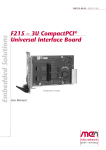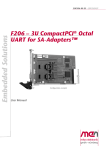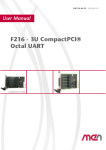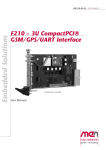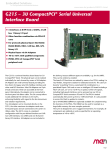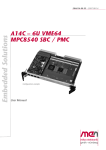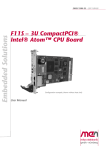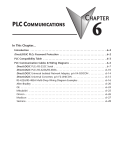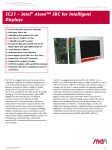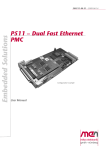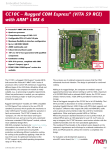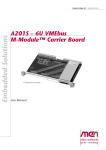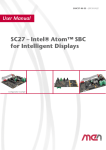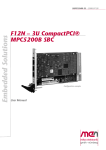Download 20G215-00 E2 User Manual
Transcript
Embedded Solutions
20G215-00 E2 – 2012-04-12
G215 – 3U CompactPCI® Serial
Universal Interface Board
Configuration example
User Manual
®
G215 – 3U CompactPCI® Serial Universal Interface Board
G215 – 3U CompactPCI® Serial Universal Interface Board
The G215 is a universal interface board based on 3U CompactPCI® Serial. The
physical layer can be realized individually for each channel by means of SAAdapters™.
SA-Adapters™ are small universal boards providing the line drivers for legacy
serial I/O, fieldbus interfaces and other small I/O functions. Most SA-Adapters™
use 9-pin D-Sub connectors which are accessible at the front panel. Alternatively,
the adapter can be connected to the front panel via ribbon cable. The SA concept
allows to add additional I/O interfaces to the G215, enhancing flexibility with regard
to the line transceivers and isolation requirements.
Two SA-Adapters™ can be mounted directly on the G215, the other maximum six
adapters need more front-panel space and are connected to the carrier via ribbon
cable. The G215 comes in a standard configuration with five pre-defined functions
on 8 HP: two CAN interfaces, two UARTs and one 8-channel binary I/O interface.
SA-Adapters™ are not included in the delivery, because different types are
available, e.g. for the UARTs. They can be ordered as needed.
The board's I/O functions are realized by means of an FPGA, making it a very
flexible, inexpensive solution for dedicated serial I/O. The card can become
"everything" from a customized I/O combination to a specialized 8-port CAN card
or even an intelligent I/O board including a Nios® soft core, on 4, 8 or 12 HP. As an
option, further I/O signals, including high-speed interfaces, can be accessed via rear
I/O on CompactPCI® Serial connectors P3 and P4. The FPGA is loaded
automatically after power-up from a 4 MB serial Flash. It is also possible to access
this Flash to update its contents.
Up to 64 MB DDR2 SDRAM are optionally available for complementing the
functions of the FPGA. This DRAM can be used for example as a large buffer
memory for more complex protocols.
The G215 is designed for use in rugged environments. For example, all components
are soldered-on and are specified for an operating temperature of -40 to +85°C.
MEN Mikro Elektronik GmbH
20G215-00 E2 – 2012-04-12
2
Technical Data
Technical Data
I/O Interfaces
• Different variations possible through FPGA IP cores and SA-Adapters™:
- RS232
- RS422
- RS485
- IBIS master/slave
- CAN bus
- HDLC
- Binary I/O
- GPS
- The FPGA offers the possibility to add customized I/O functionality. See
FPGA.
- Option matrix showing possible IP cores and SA-Adapters™ (PDF)
• Accessible via onboard connectors
- Physical interface at front panel using SA-Adapters™
- Two interfaces for direct onboard connection of SA-Adapters™
- Up to six interfaces for connection of SA-Adapters™ via 10-pin ribbon cable
• Standard factory interface configuration:
- 8 HP front panel with five SA-Adapter™ cut-outs for
- 2 CAN bus interfaces
- 2 UART interfaces
- 1 binary I/O interface
- No SA-Adapters™ included by standard; they can be selected as needed
• Standard factory FPGA configuration:
- 16Z029_CAN – CAN controller (controls CAN X1)
- 16Z029_CAN – CAN controller (controls CAN X2)
- 16Z125_UART – UART controller (controls UARTs X3/X4)
- 16Z037_GPIO – GPIO controller (8 I/O lines on X5)
Memory
• 4 MB serial Flash for FPGA configuration
Miscellaneous
• Four status LEDs at front panel
- One status LED to signal FPGA configuration (interfaces ready)
- Three user LEDs, FPGA-controlled by 16Z034_GPIO controller
CompactPCI® Serial
• Compliance with CompactPCI® Serial PICMG CPCI-S.0 Specification
• Peripheral slot
• Host interface:
- One PCI Express® x4 link
- PCIe® 1.x support
- Data rate 1 GB/s in each direction (2.5 Gbit/s per lane)
MEN Mikro Elektronik GmbH
20G215-00 E2 – 2012-04-12
3
Technical Data
Electrical Specifications
• Supply voltage/power consumption:
- +12 V (-5%/+5%), 0.125 A
Mechanical Specifications
• Dimensions: conforming to CompactPCI® Serial specification for 3U boards
• Front panel: 8 HP with ejector
- For up to five interfaces
• Weight: 168 g (w/o SA-Adapters™)
Environmental Specifications
• Temperature range (operation):
- -40..+85°C (qualified components)
- Airflow: min. 1.0 m/s
• Temperature range (storage): -40..+85°C
• Relative humidity (operation): max. 95% non-condensing
• Relative humidity (storage): max. 95% non-condensing
• Altitude: -300 m to +3000 m
• Shock:
- 15 g, 11 ms (EN 60068-2-27)
- 50 m/s², 30 ms (EN 61373)
• Bump: 10 g, 16 ms (EN 60068-2-29)
• Vibration (sinusoidal): 1 g, 10 Hz - 150 Hz (EN 60068-2-6)
• Vibration (function): 1 m/s², 5 Hz - 150 Hz (EN 61373)
• Vibration (lifetime): 7.9 m/s², 5 Hz - 150 Hz (EN 61373)
• Conformal coating on request
MTBF
• 529 954 h @ 40°C according to IEC/TR 62380 (RDF 2000)
Safety
• PCB manufactured with a flammability rating of 94V-0 by UL recognized manufacturers
EMC
• Tested according to EN 55022 (radio disturbance), IEC 61000-4-2 (ESD) and
IEC 61000-4-4 (burst)
Software Support
• Driver software for Windows®, Linux, VxWorks®, QNX®
• Flash update tools for Windows®, Linux, VxWorks®
• For more information on supported operating system versions and drivers see
online data sheet.
MEN Mikro Elektronik GmbH
20G215-00 E2 – 2012-04-12
4
Block Diagram
Block Diagram
DDR2 RAM
F
Front connector
SA
SA‐Adapter™
Options
4 HP 4 HP 4 HP (additional)
F
SA
B
CAN bus
F
SA
B
CAN bus
F
SA
UART
F
SA
UART
SA
F
B
F
SA
F
SA
B
F
SA
B
Binary I/O
CompactPCI® Serial
Rear I/O signals
FPGA
Cyclone™ IV
P4
P3
PCIe x4
MEN Mikro Elektronik GmbH
20G215-00 E2 – 2012-04-12
Custom I/O
P1
5
Configuration Options
Configuration Options
Physical Layers
• Via up to eight SA-Adapters™
• Different variations possible through FPGA IP cores and SA-Adapters™:
- RS232
- RS422
- RS485
- IBIS master/slave
- CAN bus
- HDLC
- Binary I/O
- GPS
- Other physical layers dependent on FPGA configuration
- Option matrix showing possible IP cores and SA-Adapters™ (PDF)
FPGA
• FPGA Altera® Cyclone® IV EP4CGX30, EP4CGX75 or EP4CGX150, see
FPGA
Memory
• 16 MB, 32 MB, 64 MB DDR2 SDRAM, FPGA-controlled, e.g., as a buffer
memory for more complex protocols
Rear I/O
• Up to 128 I/O signals on CompactPCI® Serial connectors P3 and P4
- FPGA-controlled
- Also for high-speed interfaces
- In addition to SA-Adapter™ I/O
Mechanical
• 4, 8 or 12 HP front panel dependent on number of SA-Adapters™
- 4 HP with 2 onboard SA-Adapters™
- 8 HP with 5 SA-Adapters™ (standard)
- 12 HP with 8 SA-Adapters™
• One-piece front panel
Cooling Concept
• Also available with conduction cooling in MEN CCA frame
Please note that some of these options may only be available for large volumes.
Please ask our sales staff for more information.
For available standard configurations see online data sheet.
MEN Mikro Elektronik GmbH
20G215-00 E2 – 2012-04-12
6
FPGA
FPGA
This product offers the possibility to add customized I/O functionality in FPGA.
Flexible Configuration
• Customized I/O functions can be added to the FPGA.
• It depends on the board type, pin counts and number of logic elements which IP
cores make sense and/or can be implemented. Please contact MEN for information on feasibility.
• You can find more information on our web page "User I/O in FPGA"
FPGA Capabilities
• FPGA Altera® Cyclone® IV EP4CGX30 (Standard)
- 29 440 logic elements
- 1080 Kbits total RAM
• FPGA Altera® Cyclone® IV EP4CGX75 (Option)
- 73 920 logic elements
- 4158 Kbits total RAM
• FPGA Altera® Cyclone® IV EP4CGX150 (Option)
- 149 760 logic elements
- 6480 Kbits total RAM
• For interface functions
• 4 MB external Flash for FPGA configurations
• Connection
- Pin count on onboard SA-Adapter™ connectors: 64 pins
- SA-Adapters™ are used to realize the physical lines.
- Option: Connection via CompactPCI® Serial rear I/O P3 and P4, pin count:
128 pins
• Functional updates via software
- MEN offers Flash update tools for different operating systems.
• Option matrix showing possible IP cores and SA-Adapters™ (PDF)
MEN Mikro Elektronik GmbH
20G215-00 E2 – 2012-04-12
7
Product Safety
Product Safety
!
Electrostatic Discharge (ESD)
Computer boards and components contain electrostatic sensitive devices.
Electrostatic discharge (ESD) can damage components. To protect the board and
other components against damage from static electricity, you should follow some
precautions whenever you work on your computer.
• Power down and unplug your computer system when working on the inside.
• Hold components by the edges and try not to touch the IC chips, leads, or circuitry.
• Use a grounded wrist strap before handling computer components.
• Place components on a grounded antistatic pad or on the bag that came with the
component whenever the components are separated from the system.
• Store the board only in its original ESD-protected packaging. Retain the original
packaging in case you need to return the board to MEN for repair.
MEN Mikro Elektronik GmbH
20G215-00 E2 – 2012-04-12
8
About this Document
About this Document
This user manual describes the hardware functions of the board, connection of
peripheral devices and integration into a system. It also provides additional
information for special applications and configurations of the board.
The manual does not include detailed information on individual components (data
sheets etc.). A list of literature is given in the appendix.
History
Issue
Comments
Date
E1
First issue
2011-06-20
E2
Complete review of manual, especially links, drawings and description of driver software; added pin
assignment of P1
2012-04-12
Conventions
!
italics
bold
monospace
This sign marks important notes or warnings concerning proper functionality of the
product described in this document. You should read them in any case.
Folder, file and function names are printed in italics.
Bold type is used for emphasis.
A monospaced font type is used for hexadecimal numbers, listings, C function
descriptions or wherever appropriate. Hexadecimal numbers are preceded by "0x".
comment
Comments embedded into coding examples are shown in green color.
hyperlink
Hyperlinks are printed in blue color.
The globe will show you where hyperlinks lead directly to the Internet, so you can
look for the latest information online.
IRQ#
/IRQ
Signal names followed by "#" or preceded by a slash ("/") indicate that this signal is
either active low or that it becomes active at a falling edge.
in/out
Signal directions in signal mnemonics tables generally refer to the corresponding
board or component, "in" meaning "to the board or component", "out" meaning
"coming from it".
Vertical lines on the outer margin signal technical changes to the previous issue of
the document.
MEN Mikro Elektronik GmbH
20G215-00 E2 – 2012-04-12
9
About this Document
Legal Information
Changes
MEN Mikro Elektronik GmbH ("MEN") reserves the right to make changes without further notice to any products
herein.
Warranty, Guarantee, Liability
MEN makes no warranty, representation or guarantee of any kind regarding the suitability of its products for any
particular purpose, nor does MEN assume any liability arising out of the application or use of any product or
circuit, and specifically disclaims any and all liability, including, without limitation, consequential or incidental
damages. TO THE EXTENT APPLICABLE, SPECIFICALLY EXCLUDED ARE ANY IMPLIED
WARRANTIES ARISING BY OPERATION OF LAW, CUSTOM OR USAGE, INCLUDING WITHOUT
LIMITATION, THE IMPLIED WARRANTIES OF MERCHANTABILITY AND FITNESS FOR A
PARTICULAR PURPOSE OR USE. In no event shall MEN be liable for more than the contract price for the
products in question. If buyer does not notify MEN in writing within the foregoing warranty period, MEN shall
have no liability or obligation to buyer hereunder.
The publication is provided on the terms and understanding that:
1. MEN is not responsible for the results of any actions taken on the basis of information in the publication, nor
for any error in or omission from the publication; and
2. MEN is not engaged in rendering technical or other advice or services.
MEN expressly disclaims all and any liability and responsibility to any person, whether a reader of the publication
or not, in respect of anything, and of the consequences of anything, done or omitted to be done by any such person
in reliance, whether wholly or partially, on the whole or any part of the contents of the publication.
Conditions for Use, Field of Application
The correct function of MEN products in mission-critical and life-critical applications is limited to the
environmental specification given for each product in the technical user manual. The correct function of MEN
products under extended environmental conditions is limited to the individual requirement specification and
subsequent validation documents for each product for the applicable use case and has to be agreed upon in writing
by MEN and the customer. Should the customer purchase or use MEN products for any unintended or
unauthorized application, the customer shall indemnify and hold MEN and its officers, employees, subsidiaries,
affiliates, and distributors harmless against all claims, costs, damages, and expenses, and reasonable attorney fees
arising out of, directly or indirectly, any claim or personal injury or death associated with such unintended or
unauthorized use, even if such claim alleges that MEN was negligent regarding the design or manufacture of the
part. In no case is MEN liable for the correct function of the technical installation where MEN products are a part
of.
Trademarks
All products or services mentioned in this publication are identified by the trademarks, service marks, or product
names as designated by the companies which market those products. The trademarks and registered trademarks
are held by the companies producing them. Inquiries concerning such trademarks should be made directly to those
companies.
Conformity
MEN products are no ready-made products for end users. They are tested according to the standards given in the
Technical Data and thus enable you to achieve certification of the product according to the standards applicable in
your field of application.
MEN Mikro Elektronik GmbH
20G215-00 E2 – 2012-04-12
10
About this Document
RoHS
Since July 1, 2006 all MEN standard products comply with RoHS legislation.
Since January 2005 the SMD and manual soldering processes at MEN have already been completely lead-free.
Between June 2004 and June 30, 2006 MEN’s selected component suppliers have changed delivery to RoHScompliant parts. During this period any change and status was traceable through the MEN ERP system and the
boards gradually became RoHS-compliant.
WEEE Application
The WEEE directive does not apply to fixed industrial plants and tools. The compliance is the responsibility of the
company which puts the product on the market, as defined in the directive; components and sub-assemblies are
not subject to product compliance.
In other words: Since MEN does not deliver ready-made products to end users, the WEEE directive is not
applicable for MEN. Users are nevertheless recommended to properly recycle all electronic boards which have
passed their life cycle.
Nevertheless, MEN is registered as a manufacturer in Germany. The registration number can be provided on
request.
Copyright © 2012 MEN Mikro Elektronik GmbH. All rights reserved.
Germany
MEN Mikro Elektronik GmbH
Neuwieder Straße 3-7
90411 Nuremberg
Phone +49-911-99 33 5-0
Fax +49-911-99 33 5-901
E-mail [email protected]
www.men.de
MEN Mikro Elektronik GmbH
20G215-00 E2 – 2012-04-12
France
MEN Mikro Elektronik SA
18, rue René Cassin
ZA de la Châtelaine
74240 Gaillard
Phone +33 (0) 450-955-312
Fax +33 (0) 450-955-211
E-mail [email protected]
www.men-france.fr
USA
MEN Micro, Inc.
24 North Main Street
Ambler, PA 19002
Phone (215) 542-9575
Fax (215) 542-9577
E-mail [email protected]
www.menmicro.com
11
Contents
Contents
1 Getting Started . . . . . . . . . . . . . . . . . . . . . . . . . . . . . . . . . . . . . . . . . . . . . . . .
1.1 General Concept . . . . . . . . . . . . . . . . . . . . . . . . . . . . . . . . . . . . . . . . .
1.2 Front Panel and Interfaces . . . . . . . . . . . . . . . . . . . . . . . . . . . . . . . . . .
1.3 Map of the Board. . . . . . . . . . . . . . . . . . . . . . . . . . . . . . . . . . . . . . . . .
1.4 Installing SA-Adapters . . . . . . . . . . . . . . . . . . . . . . . . . . . . . . . . . . . .
1.4.1
Direct Connection (X1, X2) . . . . . . . . . . . . . . . . . . . . . . . . .
1.4.2
Connection via Ribbon Cable (X3, X4, X5) . . . . . . . . . . . . .
1.5 Integrating the Board into a System . . . . . . . . . . . . . . . . . . . . . . . . . .
1.6 Installing Driver Software . . . . . . . . . . . . . . . . . . . . . . . . . . . . . . . . . .
14
14
15
16
17
17
19
22
22
2 Functional Description . . . . . . . . . . . . . . . . . . . . . . . . . . . . . . . . . . . . . . . . . .
2.1 Power Supply. . . . . . . . . . . . . . . . . . . . . . . . . . . . . . . . . . . . . . . . . . . .
2.2 Board Configuration . . . . . . . . . . . . . . . . . . . . . . . . . . . . . . . . . . . . . .
2.2.1
I/O Interfaces. . . . . . . . . . . . . . . . . . . . . . . . . . . . . . . . . . . . .
2.2.2
Nios Soft Processor . . . . . . . . . . . . . . . . . . . . . . . . . . . . . . . .
2.2.3
DDR2 SDRAM Memory . . . . . . . . . . . . . . . . . . . . . . . . . . .
2.3 Standard Interfaces . . . . . . . . . . . . . . . . . . . . . . . . . . . . . . . . . . . . . . .
2.3.1
CAN Bus Interfaces . . . . . . . . . . . . . . . . . . . . . . . . . . . . . . .
2.3.2
UART Interfaces . . . . . . . . . . . . . . . . . . . . . . . . . . . . . . . . . .
2.3.3
Binary I/O Interface . . . . . . . . . . . . . . . . . . . . . . . . . . . . . . .
2.4 Front-Panel LEDs . . . . . . . . . . . . . . . . . . . . . . . . . . . . . . . . . . . . . . . .
2.5 CompactPCI Serial . . . . . . . . . . . . . . . . . . . . . . . . . . . . . . . . . . . . . . .
2.5.1
Rear I/O on P3 and P4. . . . . . . . . . . . . . . . . . . . . . . . . . . . . .
23
23
23
23
23
23
24
24
25
30
31
32
32
3 FPGA . . . . . . . . . . . . . . . . . . . . . . . . . . . . . . . . . . . . . . . . . . . . . . . . . . . . . . . . 33
3.1 General . . . . . . . . . . . . . . . . . . . . . . . . . . . . . . . . . . . . . . . . . . . . . . . . 33
3.2 Standard Factory FPGA Configuration . . . . . . . . . . . . . . . . . . . . . . . . 34
4 Appendix . . . . . . . . . . . . . . . . . . . . . . . . . . . . . . . . . . . . . . . . . . . . . . . . . . . . .
4.1 Assignment of Onboard Connectors to Front-Panel Slots. . . . . . . . . .
4.2 Literature and Web Resources . . . . . . . . . . . . . . . . . . . . . . . . . . . . . . .
4.2.1
CAN Bus . . . . . . . . . . . . . . . . . . . . . . . . . . . . . . . . . . . . . . . .
4.2.2
CompactPCI Serial . . . . . . . . . . . . . . . . . . . . . . . . . . . . . . . .
4.3 Finding out the Board’s Article Number, Revision and Serial
Number . . . . . . . . . . . . . . . . . . . . . . . . . . . . . . . . . . . . . . . . . . . . . . . .
MEN Mikro Elektronik GmbH
20G215-00 E2 – 2012-04-12
35
35
36
36
36
36
12
Figures
Figure 1.
Figure 2.
Figure 3.
Figure 4.
Figure 5.
Figure 6.
Front panel and interfaces. . . . . . . . . . . . . . . . . . . . . . . . . . . . . . . . . . . 15
Map of the board (top view) . . . . . . . . . . . . . . . . . . . . . . . . . . . . . . . . . 16
Installing SA-Adapters on G215 directly . . . . . . . . . . . . . . . . . . . . . . . 18
G215 with one CAN-bus SA-Adapter on X1. . . . . . . . . . . . . . . . . . . . 18
Installing SA-Adapters via ribbon cable in slots X3, X4 and X5. . . . . 20
G215 with one CAN-bus SA-Adapter on X2 and one RS232 SA-Adapter
on X4 . . . . . . . . . . . . . . . . . . . . . . . . . . . . . . . . . . . . . . . . . . . . . . . . . . 21
Figure 7. FPGA – Block diagram (exemplary) . . . . . . . . . . . . . . . . . . . . . . . . . . 33
Figure 8. Assignment of onboard connectors to front-panel slots . . . . . . . . . . . . 35
Figure 9. Labels giving the board’s article number, revision and serial number. 36
Tables
Table 1.
Pin assignment of the 10-pin CAN bus receptacle connectors
(X1/X2). . . . . . . . . . . . . . . . . . . . . . . . . . . . . . . . . . . . . . . . . . . . . . . . .
Table 2. Signal mnemonics of CAN bus interfaces (X1/X2) . . . . . . . . . . . . . . .
Table 3. Pin assignment of UARTs (X3/X4) on the 40-pin connector
for RS232 . . . . . . . . . . . . . . . . . . . . . . . . . . . . . . . . . . . . . . . . . . . . . . .
Table 4. Pin assignment of UARTs (X3/X4) on the 40-pin connector
for RS422 . . . . . . . . . . . . . . . . . . . . . . . . . . . . . . . . . . . . . . . . . . . . . . .
Table 5. Pin assignment of UARTs (X3/X4) on the 40-pin connector
for RS485 . . . . . . . . . . . . . . . . . . . . . . . . . . . . . . . . . . . . . . . . . . . . . . .
Table 6. Signal mnemonics of UART interfaces (X3/X4) . . . . . . . . . . . . . . . . .
Table 7. Supported and tested baud rates . . . . . . . . . . . . . . . . . . . . . . . . . . . . . .
Table 8. Pin assignment of binary I/O lines (X5) on the 40-pin connector . . . .
Table 9. Signal mnemonics of binary I/O interface (X5) . . . . . . . . . . . . . . . . . .
Table 10. Front-panel LEDs . . . . . . . . . . . . . . . . . . . . . . . . . . . . . . . . . . . . . . . . .
Table 11. Pin assignment of CompactPCI Serial P1 connector . . . . . . . . . . . . . .
Table 12. Assignment of onboard connectors to front-panel slots . . . . . . . . . . . .
MEN Mikro Elektronik GmbH
20G215-00 E2 – 2012-04-12
24
24
26
26
26
27
29
30
31
31
32
35
13
Getting Started
1
Getting Started
This chapter gives an overview of the board and hints for first installation in a system.
1.1
General Concept
The G215 is a universal interface board with a maximum of 8 interfaces. All of the
board's I/O functions are realized inside its FPGA, making it a very flexible solution
for dedicated serial I/O. The physical layer is implemented individually for each
channel by means of MEN standard SA-Adapters.
Two SA-Adapters can be mounted directly on the G215, the other maximum six
adapters need more front-panel space and are connected via ribbon cable.
The standard version of G215 lets you connect up to five SA-Adapters to implement
its line interfaces on 8 HP (two slots). Two SA-Adapters for CAN bus can be
mounted directly on the board (see Chapter 1.4.1 Direct Connection (X1, X2) on
page 17), the other three adapters (two UARTs, one binary I/O interface) are
connected via ribbon cable and led to the second front-panel slot (see Chapter 1.4.2
Connection via Ribbon Cable (X3, X4, X5) on page 19).
Suitable SA-Adapters are available for all interface types of the standard version,
with different options for the UARTs, e.g., RS232, RS422/485 or IBIS master/slave.
With two additional connectors assembled, the G215 supports up to eight different
interfaces.
As an additional option, the G215 also supports FPGA-based rear I/O on
CompactPCI connectors P3 and P4.
For ordering information of available SA-Adapters please see the G215 data sheet
on MEN’s website.
Ask our sales team for tailor-made, custom assembly and configuration options.
For details on...
• CAN bus functions see Chapter 2.3.1 CAN Bus Interfaces on page 24.
• UART functions see Chapter 2.3.2 UART Interfaces on page 25.
• binary I/O functions see Chapter 2.3.3 Binary I/O Interface on page 30.
• front-panel LEDs see Chapter 2.4 Front-Panel LEDs on page 31.
• FPGA see Chapter 3 FPGA on page 33.
MEN Mikro Elektronik GmbH
20G215-00 E2 – 2012-04-12
14
Getting Started
1.2
Front Panel and Interfaces
The G215 has five slots for standard 9-pin D-Sub connectors at the front. The
standard configuration includes two CAN-bus interfaces, two UARTs and one 8-bit
binary I/O port.
Figure 1. Front panel and interfaces
Additional Interfaces
(Option)
G215 Standard
®
UART
X3
X6
UART
X4
X7
Binary I/O
X2
CAN bus
X1
CAN bus
1 2 3 4
X5
X8
G215
MEN Mikro Elektronik GmbH
20G215-00 E2 – 2012-04-12
15
Getting Started
1.3
Map of the Board
Figure 2. Map of the board (top view)
10‐pin plugs (option for two additional ports)
LEDs
SA‐Adapter connector
for CAN bus
CompactPCI Serial
connectors P3 and P4
(for optionally leading up to 128 additional FPGA
signals to the rear)
SA‐Adapter "X1"
X6
1
X7
1
X3
X4
SA‐Adapter connector
for CAN bus
SA‐Adapter "X2"
X8
1
1
X5
1
("X6" free for additional FPGA‐
core interface)
1
40‐pin connector for SA‐Adapters
"X3" to "X5" via ribbon cable
(2 RS232,
1 binary I/O interface)
1
1
CompactPCI Serial Connector P1
MEN Mikro Elektronik GmbH
20G215-00 E2 – 2012-04-12
16
Getting Started
1.4
Installing SA-Adapters
1.4.1
Direct Connection (X1, X2)
Two SA-Adapters can be mounted directly on the G215 on the 10-pin receptacle
connectors "X1" and "X2".
Make sure that the adapter matches the standard dimensions for SA-Adapters.
(See also installation hints in the adapter’s user manual or the list of compatible
accessories in the G215 data sheet on MEN’s website.)
Power down your system and remove the G215 from the system.
Remove the front panel: Loosen and remove the two screws highlighted in red.
Screws to uninstall front panel
Remove the two front panel screws and the two screws on top of the mounting
bolts of the SA-Adapter.
MEN Mikro Elektronik GmbH
20G215-00 E2 – 2012-04-12
17
Getting Started
CAN bus
X2
CAN bus
X1
1 2 3 4
Remove the blind connector from the front panel, if you need a slot that is covered: Loosen the two screws at the front of the panel (highlighted in red in the
drawing).
Hint: Hold the screw in place with a suitable tool from the back of the panel,
then loosen the screw at the front.
The SA-Adapter is plugged on the G215 with the component sides of the PCBs
facing each other.
Carefully put it down, making sure that the connectors are properly aligned.
Press the SA-Adapter firmly onto the G215.
Reinstall the front panel: Place the front panel back over the connectors, taking
care not to damage the LEDs.
Fasten the SA-Adapter at the front panel using the two screws that were supplied with the SA-Adapter in a separate bag.
Screw the SA-Adapter tightly to the G215 PCB using the two screws removed
before.
Figure 3. Installing SA-Adapters on G215 directly
D‐Sub front connector
10‐pin receptacle
40‐pin plug
G215
2 M3x6 TX8 screws
Figure 4. G215 with one CAN-bus SA-Adapter on X1
Picture shows a similar board
MEN Mikro Elektronik GmbH
20G215-00 E2 – 2012-04-12
18
Getting Started
1.4.2
Connection via Ribbon Cable (X3, X4, X5)
A suitable 40-pin connector with ribbon cables leading to three 10-pin SA-Adapter
receptacles is included in the delivery of the G215. This allows easy installation of
SA-Adapters in slots "X3", "X4" and "X5".
!
Note: MEN gives no warranty on functionality and reliability of the board and SAAdapters used if you install SA-Adapters in a different way than described in
MEN’s documentation.
Perform the following steps to install SA-Adapters in X3, X4 or X5:
Make sure that the adapter matches the standard dimensions for SA-Adapters.
(See also installation hints in the adapter’s user manual or the list of compatible
accessories in the G215 data sheet on MEN’s website.)
Power-down your system and remove the G215 from the system.
UART
UART
X5
X4
X3
Remove the blind connector from the additional front panel: Loosen one of the
screw pairs highlighted in the drawing.
Digital I/O
Remove the two front panel screws and the two screws on top of the mounting
bolts of the SA-Adapter.
MEN Mikro Elektronik GmbH
20G215-00 E2 – 2012-04-12
19
Getting Started
Plug the 40-pin connector with the three prefolded ribbon cables to the 40-pin
plug of the carrier board and close the metal locks.
Metal locks
Picture shows a similar board
Plug the suitable 10-pin connector of the ribbon cable to the respective 10-pin SAAdapter connector.
Make sure to always align the pins correctly (pin 1 is marked by a triangle on the
ribbon cable connector).
Fasten the SA-Adapter at the front panel using the two screws that were supplied with the SA-Adapter in a separate bag.
Figure 5. Installing SA-Adapters via ribbon cable in slots X3, X4 and X5
Ribbon cable
D‐Sub front connector
10‐pin receptacle
40‐pin plug
G215
You can now reinsert the board and the additional front panel into your system.
Make sure to fasten the SA-Adapter front panel appropriately in your enclosure!
MEN Mikro Elektronik GmbH
20G215-00 E2 – 2012-04-12
20
Getting Started
Figure 6. G215 with one CAN-bus SA-Adapter on X2 and one RS232 SA-Adapter
on X4
Picture shows a similar board
MEN Mikro Elektronik GmbH
20G215-00 E2 – 2012-04-12
21
Getting Started
1.5
Integrating the Board into a System
You can use the following check list when installing the board in a system for the
first time.
Install the desired SA-Adapters on the G215. (See Chapter 1.4 Installing SAAdapters on page 17.)
Power-down the system.
Insert the G215 into a peripheral slot of your CompactPCI Serial system, making sure that the CompactPCI Serial connectors are properly aligned.
Note: The peripheral slots of every CompactPCI Serial system are marked by a
circle with a plus sign behind it on the backplane and/or at the front
panel.
Power-up the system.
You can now install driver software for the G215 I/O interfaces.
1.6
Installing Driver Software
For a detailed description on how to install driver software please refer to the
respective documentation.
You can find any driver software available for download on MEN’s website.
MEN Mikro Elektronik GmbH
20G215-00 E2 – 2012-04-12
22
Functional Description
2
Functional Description
2.1
Power Supply
The G215 is supplied with a primary +12V voltage via the CompactPCI Serial
connector P1. As an option, the board can also be supplied with +5V.
2.2
Board Configuration
The G215 has a fixed standard configuration for you to get started. However, the
board is completely open for a final configuration that 100% suits your application.
In addition to the possible hardware configuration and assembly options explained
in Chapter 1.1 General Concept on page 14, the G215 also allows to include more
advanced features. The basis of its flexibility is the G215’s Altera Cyclone IV
FPGA with 29,440 logic elements, 1,080 Kbits total RAM and 4 MB configuration
Flash. See also Chapter 3 FPGA on page 33.
In any case we recommend that you contact our sales team for tailor-made, custom
assemblies. This chapter only summarizes the board’s options.
2.2.1
I/O Interfaces
The onboard FPGA permits many possible combinations of different standard IP
cores for a total of eight interfaces. The assignment of connectors to the individual
functions is just as flexible. (See also Chapter 4.1 Assignment of Onboard
Connectors to Front-Panel Slots on page 35.)
On its website MEN provides an option matrix that includes possible functions
along with software support for the different operating systems and SA-Adapters
that can be used as physical layers.
You can also find an overview of configuration options in the G215 data sheet, also
on MEN’s website.
2.2.2
Nios Soft Processor
The G215 can become more than a pure I/O board when inexpensive intelligence is
added through a Nios soft core. A typical type would be the Nios II/f processor. It
could be utilized, for instance, to pre-process data.
A suitable design environment is available from Altera.
2.2.3
DDR2 SDRAM Memory
64 MB of DDR2 SDRAM memory can easily be added, e.g. as a buffer memory for
more complex protocols. The SDRAM is also FPGA-controlled.
MEN Mikro Elektronik GmbH
20G215-00 E2 – 2012-04-12
23
Functional Description
2.3
Standard Interfaces
2.3.1
CAN Bus Interfaces
The G215 offers two CAN interfaces on two 10-pin receptacle connectors for direct
connection of MEN SA-Adapters, which have standard 9-pin D-Sub connectors.
The CAN controller is a standard IP core from MEN called 16Z029_CAN. MEN
offers a standard adapter for CAN bus, the SA8.
The interfaces support the 2.0 A/B CAN protocol. Typical CAN-bus bit rates are:
•
•
•
•
•
•
•
1 Mbit/s (maximum)
800 kbit/s
500 kbit/s
250 kbit/s
125 kbit/s
100 kbit/s
50 kbit/s (minimum)
Please see MEN’s website for ordering information of SA-Adapters.
You can find more information in the 16Z029_CAN data sheet on MEN’s website.
Please see MEN’s website for up-to-date driver software and documentation.
See also Chapter 4.2 Literature and Web Resources on page 36 for literature on
CAN bus.
2.3.1.1
Connection
Connector types:
• 10-pin receptacle, 2.54 mm pitch, for SA-Adapter connection
Mating connector:
• 10-pin SA-Adapter plug
Table 1. Pin assignment of the 10-pin CAN bus receptacle connectors (X1/X2)
9
10
1
2
9
-
10
-
7
-
8
-
5
-
6
-
3
CAN_TX
4
CAN_RX
1
GND
2
VCC
Table 2. Signal mnemonics of CAN bus interfaces (X1/X2)
Signal
Function
CAN_RX
in
CAN bus data receive line
CAN_TX
out
CAN bus data transmit line
GND
-
Reference potential
VCC
out
Power supply
MEN Mikro Elektronik GmbH
20G215-00 E2 – 2012-04-12
Direction
24
Functional Description
2.3.2
UART Interfaces
The G215 offers two standard UARTs that can be configured as a non-differential
(single-ended) RS232, or differential RS422 (full duplex) or RS485 (half duplex)
interface with full handshake support. The physical layers are defined through SAAdapters, and can be set individually for each channel through software. (See
software documentation for more details.)
MEN provides a range of standard adapters with different line interfaces, e.g.
RS232, RS422/485, or IBIS.
The UART controller is a standard IP core from MEN called 16Z125_UART.
Please see MEN’s website for ordering information of SA-Adapters.
You can find more information in the 16Z125_UART data sheet on MEN’s website.
Please see MEN’s website for up-to-date driver software and documentation.
The register set of the octal UART is fully 16550D compatible. Data rates up to
921 600 bit/s are possible, depending on the physical interface type selected.
2.3.2.1
Connection
All UART ports are available on the G215’s 40-pin onboard connector. An adapter
connector with ribbon cables is included in the standard delivery to spread the 40pin connector to three SA-Adapter receptacles. (See Chapter 1.4 Installing SAAdapters on page 17.)
Note: Some SA-Adapters do not support all signals. Please refer to the user manual
of the actually used SA-Adapter for details. See Chapter 4.2 Literature and
Web Resources on page 36.
Connector types:
• 40-pin low-profile plug, 2.54 mm pitch, for ribbon-cable connection
• Mating connector:
40-pin IDC receptacle, e.g. Elco Series 8290 IDC socket
MEN Mikro Elektronik GmbH
20G215-00 E2 – 2012-04-12
25
Functional Description
Table 3. Pin assignment of UARTs (X3/X4) on the 40-pin connector for RS232
40
2
39
1
40
39
..
..
32
31
Not used
30
RI10#
29
DCD10#
28
CTS10#
27
DSR10#
26
RTS10#
25
DTR10#
24
RXD10
23
TXD10
22
+5V
21
GND
20
RI11#
19
DCD11#
18
CTS11#
17
DSR11#
16
RTS11#
11
DTR11#
14
RXD11
13
TXD11
12
+5V
11
GND
10
9
..
..
2
1
X3 UART
X4 UART
X5 binary I/O
Table 4. Pin assignment of UARTs (X3/X4) on the 40-pin connector for RS422
30
RX10-
29
-
28
TX10-
27
-
26
-
25
RX10+
24
-
23
TX10+
22
+5V
21
GND
20
RX11-
19
-
18
TX11-
17
-
16
-
11
RX11+
14
-
13
TX11+
12
+5V
11
GND
X3 UART
X4 UART
Table 5. Pin assignment of UARTs (X3/X4) on the 40-pin connector for RS485
MEN Mikro Elektronik GmbH
20G215-00 E2 – 2012-04-12
30
-
29
-
28
D10-
27
-
26
-
25
-
24
-
23
D10+
22
+5V
21
GND
20
-
19
-
18
D11-
17
-
16
-
11
-
14
-
13
D11+
12
+5V
11
GND
X3 UART
X4 UART
26
Functional Description
Table 6. Signal mnemonics of UART interfaces (X3/X4)
Mode
All modes
Signal
Direction
Function
GND
-
Ground
+5V
out
+5V supply voltage
RX+/-
in
Differential receive data
TX+/-
out
Differential transmit data
RS485
D+/-
in/out
Differential transceive data
RS232
CTS
in
Clear to send
DCD
in
Data carrier detected
DSR
in
Data set ready
DTR
out
Data terminal ready
RI
in
Ring indicator
RTS
out
Request to send
RXD
in
Receive data
TXD
out
Transmit data
RS422
2.3.2.2
Setting the Physical Layer
The two UART channels can be configured individually as differential RS422 or
RS485, or non-differential (single-ended) RS232 interfaces. The setting is made
using driver software. For Windows MEN offers a driver installation package that
allows easy configuration through the Device Manager. For Linux, VxWorks and
QNX MEN also offers driver software that provides the necessary functions to write
application software.
The following chapters give hints on how to make settings under the supported
operating systems.
For further details on the different driver packages, please refer to the respective
software documentation.
Please see MEN’s website for up-to-date driver software and documentation.
2.3.2.3
Configuration under Windows
MEN’s driver installation package (Installset) for Windows allows easy
configuration through the Device Manager.
To do this, open the Properties page of each G215 UART device via the Windows
Device Manager, select the Port Interface tab and choose the used physical
interface.
You can find more details on the Windows Installset in the F215 and G215 Windows Installset User Manual.
You can download the Windows driver and user manual from MEN’s website.
MEN Mikro Elektronik GmbH
20G215-00 E2 – 2012-04-12
27
Functional Description
2.3.2.4
Configuration under Linux
MEN provides a Linux driver that allows to configure the interface mode and baud
rate.
You can download the Linux driver and documentation from MEN’s website.
The baud_base parameter must be set to 1843200.
MEN’s Linux driver supports the following values for the mode parameter:
se
single ended (RS232)
df_fdx
differential, full duplex (RS422)
df_hdxe
differential, half duplex, with echo (RS485)
df_hdx
differential, half duplex, no echo (RS485)
The following examples show how to use the driver with G215.
Set all UART ports to RS232 mode
# modprobe men_lx_chameleon usePciIrq=1
# modprobe men_lx_frodo baud_base=1843200 mode=se,se
Set all UART ports to RS422 full-duplex mode
In order to change the settings, the driver needs to be removed first.
# rmmod men_lx_frodo
# modprobe men_lx_frodo baud_base=1843200 mode=df_fdx,df_fdx
!
Note: Most Linux kernels only support 4 UARTs by default. If you need more than
4 UARTs, add parameter 8250.nr_uarts=48 to your kernel boot line in the
bootloader or adjust kernel parameter CONFIG_NR_8250_UARTS and
recompile the kernel.
2.3.2.5
Configuration under VxWorks
MEN provides a VxWorks driver that provides comprehensive I/O control support
to configure the interfaces.
You can find more details on MEN’s VxWorks driver software in the driver’s
included HTML documentation.
You can download the VxWorks driver from MEN’s website.
The UART clock frequency must be set to 58982400. You can use driver function
Z25_CreateDevice or Z25_SetBaseBaud to do this.
MEN Mikro Elektronik GmbH
20G215-00 E2 – 2012-04-12
28
Functional Description
2.3.2.6
Configuration under QNX
MEN provides a QNX driver that allows configuration of the interfaces through
QNX tool stty.
The stty tool together with MEN’s QNX driver provides a large number of
parameters to configure serial interfaces. MEN’s driver includes options to set the
physical interface itself. You can get details on the driver using QNX command use
devc-serz025.
You can download the QNX driver from MEN’s website.
To get details on the driver use QNX command use devc-serz025.
You can find more information on stty also on the QNX developer community website.
2.3.2.7
Supported Baud Rates
The G215 provides highly accurate baud rates. The following baud rates are
supported and tested1.
Table 7. Supported and tested baud rates
Desired Baud Rate [bit/s]
!
RS422
RS485
RS232
110
x
x
x
300
x
x
x
1200
x
x
x
2400
x
x
x
4800
x
x
x
9600
x
x
x
19200
x
x
x
38400
x
x
x
57600
x
x
x
115200
x
x
x
230400
x
x
x
460800
x
x
921600
x
x
Please note that at higher baudrates the system performance has to be sufficient to
process the receive interrupts fast enough to prevent the internal FIFOs from
overrunning. It may also be reasonable to reduce the FIFO trigger levels of the G215
UARTs.
1
Other settings are possible but are not tested.
MEN Mikro Elektronik GmbH
20G215-00 E2 – 2012-04-12
Supported with
29
Functional Description
2.3.3
Binary I/O Interface
The G215 provides 8 I/O ports via a serial SPI interface. The GPIO controller with
serial interface is a standard IP core from MEN called 16Z037_GPIO.
MEN’s standard binary I/O SA-Adapter, the SA15, de-serializes the SPI data stream
and gives access to individual I/O lines at its peripheral connector.
You can control the I/O lines using MDIS5 driver software available from MEN. By
default, the GPIOs are configured as inputs. This configuration can be changed
through the driver software.
Please see MEN’s website for ordering information of SA-Adapters.
You can find more information in the 16Z037_GPIO data sheet on MEN’s website.
Please see MEN’s website for up-to-date driver software and documentation.
2.3.3.1
Connection
The binary I/O signals are available on the G215’s 40-pin onboard connector. An
adapter connector with ribbon cables is included in the standard delivery to spread
the 40-pin connector to three SA-Adapter receptacles. (See Chapter 1.4 Installing
SA-Adapters on page 17.)
Connector types:
• 40-pin low-profile plug, 2.54 mm pitch, for ribbon-cable connection
• Mating connector:
40-pin IDC receptacle, e.g. Elco Series 8290 IDC socket
Table 8. Pin assignment of binary I/O lines (X5) on the 40-pin connector
40
2
MEN Mikro Elektronik GmbH
20G215-00 E2 – 2012-04-12
39
1
40
39
..
..
32
31
30
29
..
..
22
21
20
19
..
..
12
11
Not used
X3 UART
X4 UART
10
-
9
-
8
-
7
BINSCS
6
-
5
BINSCLK
4
BINSDOUT
3
BINSDIN
2
VCC +5V
1
GND
X5 binary I/O
30
Functional Description
Table 9. Signal mnemonics of binary I/O interface (X5)
Signal
Direction
Function
BINSCLK
out
Data clock (SPI interface)
BINSCS
out
Sync signal for the SPI data interface
BINSDIN
in
Serial data for binary inputs (SPI interface)
BINSDOUT
out
Serial data for binary outputs (SPI interface)
GND
-
Digital ground
VCC +5V
out
Power supply +5V DC
2.4
Front-Panel LEDs
The G215 has four status LEDs at the front panel. Three of them are controlled
through the onboard FPGA (MEN standard 16Z034_GPIO controller). These lines
are user LEDs driven by GPIO lines 0, 1 and 2. Programming these signals as
outputs and driving them to logic 0 means the LED is turned on.
You can control the GPIO lines for the three user LEDs using MDIS5 driver
software available on MEN’s website.
The green FPGA configured LED lights up as soon as the FPGA is loaded, i.e. when
the UART interfaces are ready for operation.
Table 10. Front-panel LEDs
LED No. / Color
1 2 3 4
MEN Mikro Elektronik GmbH
20G215-00 E2 – 2012-04-12
Function
1 - red
User LED, controlled through GPIO0
2 - yellow
User LED, controlled through GPIO1
3 - yellow
User LED, controlled through GPIO2
4 - green
FPGA configured, lights up when the FPGA is
loaded, not GPIO-controlled
31
Functional Description
2.5
CompactPCI Serial
The G215 uses one PCI Express x4 link at the backplane according to the
CompactPCI Serial specification (PICMG CPCI-S.0).
For a detailed description of the signals please refer to the CompactPCI Serial
specification.
Connector type of P1:
• 72-pin Airmax VS 4 pair, right angle header, 6 IMLA with end walls
Table 11. Pin assignment of CompactPCI Serial P1 connector
A
1
PE_
Rx03-
PE_
Rx03+
GND
PE_
Tx03-
PE_
Tx03+
GND
PE_
Rx02-
PE_
Rx02+
GND
PE_
Tx02-
PE_
Tx02+
GND
6
GND
PE_
Rx01-
PE_
Rx01+
GND
PE_
Tx01-
PE_
Tx01+
GND
PE_
Rx00-
PE_
Rx00+
GND
PE_
Tx00-
PE_
Tx00+
5
-
-
GND
-
-
GND
GND
-
-
GND
4
-
-
-
GA2
-
-
-
GA0
-
-
3
-
PCIE_
EN#
GND
PE_
WAKE#
RST_
IN#
GND
GND
IPMB_S
DA
IPMB_
SCL
GND
2
GND
+12V
+12V
GND
+12V
+12V
GND
+12V
+12V
GND
STNDBY
+12V
1
L
K
J
I
H
G
F
E
D
C
B
A
2.5.1
PE_
PE_
REFCLK- REFCLK+
GA1
-
Reserved Reserved
Rear I/O on P3 and P4
The G215 offers the option of including customized rear I/O on CompactPCI Serial
connectors P3 and P4. The interfaces are implemented using IP cores in the onboard
FPGA. High-speed interfaces are also supported, with up to 128 signals.
For implementation options and pin assignments, please contact our sales team.
MEN Mikro Elektronik GmbH
20G215-00 E2 – 2012-04-12
32
FPGA
3
FPGA
3.1
General
The G215 provides an onboard FPGA. The component is a powerful Altera Cyclone
IV EP4CGX device which contains a configuration of I/O modules (IP cores). The
Wishbone bus is the uniform interface for module interconnections. Typically each
implementation contains basic system functions such as reset and interrupt control
etc. and the system library, which are also IP cores. The FPGA is connected to the
backplane via a PCI Express to Wishbone bridge.
Figure 7. FPGA – Block diagram (exemplary)
CompactPCI Serial Backplane
FPGA
PCIe‐to‐Wishbone Bridge
FPGA IP Core 1
System Unit
I/O signals
FPGA IP Core 2
...
I/O signals
FPGA IP Core n
...
I/O signals
Wishbone Interconnection
A configuration table provides the information which modules are implemented in
the current configuration. Furthermore the revision, the instance number (one
module can be instantiated more than one time), the interrupt routing and the base
address of the module are stored. At initialization time, the CPU has to read the
configuration table to get the information of the base addresses of the included
modules.
Note that with regard to the FPGA resources such as available logic elements or pins
it is not possible to grant all possible combinations of the FPGA IP cores. The
following chapter describes one possible configuration of the FPGA. Please ask our
sales staff for other configurations.
You can find an overview and descriptions of all available FPGA IP cores on MEN’s
website.
MEN Mikro Elektronik GmbH
20G215-00 E2 – 2012-04-12
33
FPGA
3.2
Standard Factory FPGA Configuration
The factory FPGA configuration for standard boards comprises the following FPGA
IP cores:
•
•
•
•
•
•
•
•
•
•
16Z024-01_Chameleon – Chameleon table
16Z091_PCI – PCI-Express-to-Wishbone Bridge
16Z069_RST – Reset controller
16Z052_GIRQ – Interrupt controller
16Z126_SERFLASH – Serial Flash controller
16Z029_CAN – CAN controller (controls CAN X1)
16Z029_CAN – CAN controller (controls CAN X2)
16Z125_UART – UART controller (controls UARTs X3/X4)
16Z037_GPIO – GPIO controller with serial interface (8 I/O lines on X5)
16Z034_GPIO – GPIO controller (3 outputs for LEDs)
MEN Mikro Elektronik GmbH
20G215-00 E2 – 2012-04-12
34
Appendix
4
Appendix
4.1
Assignment of Onboard Connectors to Front-Panel Slots
The interface designation by "Xn" is a generic numbering to facilitate allocation of
the interfaces on the front panel. The following table and figure give an example
assignment that includes the connector designations, based on the standard version
of the board.
Table 12. Assignment of onboard connectors to front-panel slots
Onboard Connector
Front-Panel Slot
Standard Function
J3
X1
CAN bus
J4
X2
CAN bus
P5
X7
Not used
P6
X8
Not used
P7, pins 1..10
X5
Binary I/O
P7, pins 11..20
X4
UART
P7, pins 21..30
X3
UART
P7, pins 31..40
X6
Not used
Figure 8. Assignment of onboard connectors to front-panel slots
G215 Standard
X1
Option
X3
X6
X4
X7
10‐pin plugs (option for two additional ports)
J3
P5
1
1
P7
X2
J4
X5
X8
MEN Mikro Elektronik GmbH
20G215-00 E2 – 2012-04-12
P6
1
1
1
35
Appendix
4.2
Literature and Web Resources
• G215 data sheet with up-to-date information and documentation:
www.men.de/products/02G215-.html
• MEN SA-Adapters:
www.men.de/products/search,SA--Adapters,accessories.1.html
4.2.1
CAN Bus
• CAN in Automation e. V.
www.can-cia.de
4.2.2
CompactPCI Serial
• CompactPCI Serial Specification PICMG CPCI-S.0 Revision 1.0:
2011; PCI Industrial Computers Manufacturers Group (PICMG)
www.picmg.org
• Introduction to CompactPCI Serial on Wikipedia:
en.wikipedia.org/wiki/CompactPCI_Serial
4.3
Finding out the Board’s Article Number, Revision and
Serial Number
MEN user documentation may describe several different models and/or hardware
revisions of the G215. You can find information on the article number, the board
revision and the serial number on two labels attached to the board.
• Article number: Gives the board’s family and model. This is also MEN’s ordering number. To be complete it must have 9 characters.
• Revision number: Gives the hardware revision of the board.
• Serial number: Unique identification assigned during production.
If you need support, you should communicate these numbers to MEN.
Figure 9. Labels giving the board’s article number, revision and serial number
Complete article number
02G215-00
00.00.00
Revision number
Serial number
MEN Mikro Elektronik GmbH
20G215-00 E2 – 2012-04-12
36




































